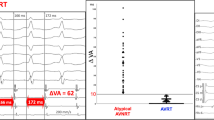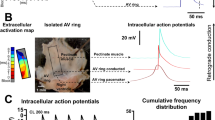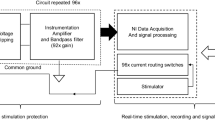Abstract
Objectives of Study: We developed a method to record extracellular A-V nodal potentials in the beating dog heart, in vivo.
Methods: In eleven Na-pentobarbital anesthetized, open-chest dogs, an octapolar electrode catheter (2 mm rings, 2 mm spacing) was inserted through a purse-string suture in the coronary sinus (CS) distal to the ostium and positioned electrographically so that the tip electrode recorded a His bundle (Hb) potential.
Results: Stable recordings of A-V nodal potentials (amplitude, 178 ± 94 μV; duration 78 ± 26 msec) were consistently made during sinus rhythm from the second and/or third bipolar pairs of electrodes. Programmed atrial stimulation and vagal stimulation resulted in loss of amplitude and increased duration of the A-V nodal potentials associated with A-H prolongation. In another series of experiments, crushing the sinus node in 6 dogs resulted in AV nodal rhythms with AV nodal potentials of varying amplitudes (132 to 840 μV) and durations (range 25 to 71 msec) as the earliest activation which preceded the Hb, atrial and ventricular deflections. One dog, showing dual AV nodal physiology as documented from the AV nodal function curve, had two distinctly different AV nodal potentials. The low-level, longer duration potentials were associated with longer (slow pathway) A-H intervals; whereas the shorter higher amplitude potentials (fast pathway) showed shorter A-H intervals, each occurring at a critical paced cycle length.
Conclusion: We conclude that consistent extracellular AV nodal electrograms can be recorded in vivo although the configuration of these potentials varies depending on heart rate, autonomic stimulation and different arrhythmic conditions such as AV nodal escape rhythms and dual AV nodal physiology.
Similar content being viewed by others
References
Erlanger J, Blackman Jr. A study of the relative rhythmicity and conductivity in various regions of the auricles of the mammalian heart. Am J Physiol 1907;19:125-174.
Hering HE. Nachweiss, dass die Verzoegerung der Erregungsueberleitung zwischen Vorhof und Kammer des Saeugetierherzens, im Tawaraschen Knoten erfolgt. Arch Ges Physiol 1910;131:572-589.
Scher AM. Direct recording from the A-V conducting system in the dog and monkey. Science 1955;121:398-399.
Scher AM, Rodriguez MI, Hamlin RL. Observations on atrioventricular conduction and on distribution of the impulse in the ventricles of ruminants and other mammals. In: Paes de Carvalho A, DeMello WC, Hoffman BF, eds. The Specialized Tissues of the Heart. New York: Elsevier, 1961:159.
Van der Kooi MW, Durrer D, Van Dam RT, Van der Tweel LH. Electrical activity in the sinus node and atrioventricular node. Am Heart J 1956;51:684-700.
Alanis J, Gonzales H, Lopez E. Electrical activity of the bundle of His. J Physiol 1958;142:127.
Alanis J, Lopez E, Mandoki JJ, Pilar G. Propagation of impulses through the atrioventricular node. Am J Physiol 1959;197:1171-1174.
Giraud G, Latour H, Puech P. L'activite' du noeud de Tawara et du faisceau de His en e'lectrocardiographie chez l'homme. Maladie Cardiovasculaires 1960;1:321.
Pruitt RD, and Essex HD. Potential changes attending the excitation process I the A-V conduction system of bovine and canine hearts. Circ Res 1960;8:149-160.
Williams JCP, Lambert EH, Titus JL. Use of intracardiac AV nodal potentials in producing complete heart block in dogs. J Appl Physiol 1969;27:740-744.
Damato AN, Lau SH, Berkowitz WD, Rosen KM, Lisi KR. Recordings of specialized conducting fibers (A-V nodal His bundle, and right bundle branch) in man using an electrode catheter technique. Circulation 1969;39:435-447.
Damato AN, Lau SH, Bobb GA, Wit AL. Recording of AV nodal activity in the intact dog heart. Amer Heart J 1970;80:353-366.
Spach MS, Leiberman M, Scott JG, Barr RC, Johnson EA, Kootsey JM. Excitation sequences of the atrial septum and the AV node in isolated hearts of the dog and rabbit. Circulation Res 1971;29:156-172.
Damato AN, Lau SH. His bundle rhythms. Circulation 1969;40:527-534.
Berbari EJ, Scherlag BJ, Lazzara R. Recordings of AV nodal potentials during junctional rhythms utilizing signal averaging. Am J Physiol 1978;235:H110-H115.
Scherlag BJ, Berbari EJ, Lazzara R. In vivo recordings of A-V nodal potentials: A review. In: Homback V, Hilger HH, Schattauer FK, eds. Signal Averaging Technique in Clinical Cardiology. Stuttgart-New York. 1981:109-119.
Scherlag BJ, Patterson E, Jackman WM, Lazzara R. The elusive extracellular AV Nodal potential: Studies from the canine heart, ex vivo. J Intervent Card Electrophysiol 2002;7:39-52.
Hirao K, Scherlag BJ, Poty H, Otomo K, Tondo C, Antz M, Patterson E, Jackman WM, Lazzara R. Electrophysiology of the atrio-AV nodal inputs and exits in the normal dog heart: Radiofrequency ablation using an epicardial approach. J Cardiovasc Electrophysiol 1971;8:904-915.
McGuire MA, DeBakker JM, Vermeulen JT, Opthof T, Becker AE, Janse MJ. Origin and significance of double potential near the atrioventricular node. Correlation of extracellular potentials, intracellular potentials and histology. Circulation 1994;89:2351-2360.
Jackman WM, Wang X, Friday KJ, et al. Catheter ablation of accessory atrioventricular pathways (Wolff-Parkinson-White syndrome) by radiofrequency current. N Engl JMed 1991;324:1605-1611.
Haissaguerre M, Gaita F, Fischer B, Commenges D, Montserrat P, d'Ivernois C, Lemetayer P, Warin JF. Elimination of atrioventricular nodal tachycardia using discrete slow potentials to guide application of radiofrequency energy. Circulation 1992;85:2162-2175.
Hoffman BF, Cranefield PF, Stuckey JH, Bagdonas AA. Electrical activity during the P-R interval. Circ Res 1960;8:1200.
Haissaguerre M, Shah DC, Jais P, Takahashi A, Hocini M, Garrigue S, Clémenty J. Slow and fast pathways ablation in AV nodal reentrant tachycardias: Anatomic approaches and pathway potentials In: Mazgalev TN, Tchou PJ, eds. Atrial-AV Nodal Electrophysiology: A View from the Millenium. NY: Futura Publishing Co. Armonk. 2000, Chapter 23, Figure 3.
Antz M, Scherlag BJ, Patterson E, Otomo K, Tondo C, Pitha J, Gonzalez MD, Jackman WM, Lazzara R. Electrophysiology of the right anterior approach to the atrioventricular node: Studies in vivo in the isolated perfused dog heart. J Cardiovasc Electrophysiol 1997;8:47-61.
Janse ML. Propagation of atrial impulse through the atrioventricular node. In: Touboul P, Waldo AL, eds. Atrial Arrhythmias: Current Concepts and Management. Mosby, Inc. St. Louis, 1990;11:143.
Mendez C, Moe GK. Demonstration of a dual A-V conduction system in the isolated rabbit heart. Circ Res 1966;19:378.
Rosen KM, Mehta A, Miller RA. Demonstration of dual atrioventricular nodal pathways in man. Am J Cardiol 1974;33(2):291-294.
Josephson ME, Miller JM. Atrioventricular node reentry tachycardias. Is the atrium a necessary link? In: Touboul P, Waldo AL, eds. Atrial Arrhythmias. Current Concepts and Management. Mosby, Inc. St. Louis. 1990:311-329.
Josephson ME, Miller JM. Atrioventricular nodal reentry: Evidence supporting and intranodal location. PACE 1993;16(II):599-614.
Iinuma H, Dreifus LS, Mazgalev T, Price R, Michelson EL. Role of the perinodal region in atrioventricular nodal reentry: Evidence in an isolated rabbit heart preparation. J Am Coll Cardiol 1983;2:465-473.
Hazlitt HA, Beckman KJ, McClelland JH, et al. Prevalence of slow A-V nodal pathway potentials in patients without A-V nodal reentrant tachycardia. J Amer Coll Cardiol 1993;21:281A (abstract).
Patterson E, Scherlag BJ. Longitudinal dissociation within the posterior AV nodal input of the rabbit: A substrate for AV nodal reentry. Circulation 1991;99:143-155.
Yamabe H, Misumi I, Fukushima H, Ueno K, Kimura Y, Hokamura Y. Electrophysiological delineation of the tachycardia circuit in atrioventricular nodal reentrant tachycardia. Circulation 1999;100:621-627.
Yamabe H, Shimasaki Y, Honda O, Kimura Y, Hokamura Y. Demonstration of the exact anatomic tachycardia circuit in the fast-slow form of atrioventricular nodal reentrant tachycardia. Circulation 2001;104:1268-1273.
Scherlag BJ, Patterson E, Hirao K, Jackman WM, Lazzara R. Changing concepts of AV nodal conduction: Basic and clinical correlates. Primary Cardiology 1995;21:13-24.
Moe GK, Cohen W, Vick RL. Experimentally induced paroxysmal AV nodal tachycardia in the dog. A “case report.” Amer Heart J 1963;65:87-92.
Inoue S, Becker A. Posterior extension of human compact atrioventricular node: A neglected anatomic feature of potential clinical significance. Circulation 1998;97:188-193.
Racker DK. Atrioventricular node and input pathways: A correlated gross anatomical and histological study of the canine atrioventricular junctional region. Anat Rec 1989;224:336-354.
Scherlag BJ, Antz M, Otomo K, Tondo C, Patterson E, Lazzara R, Jackman WM. Atrial inputs as determinants of atrioventricular nodal conduction: Re-evaluation and new concepts. Cardiologia 1995;40:753-761.
Scherlag BJ, Patterson E, Yamanashi WS, Jackman WM, Lazzara R. The AV conjunction: A concept based on ablation techniques in the normal heart. In: Mazgalev TN, Tchou PJ, eds. Atrial-AV Nodal Electrophysiology: A View from the Millennium. Futura Publishing Co., Armonk, NY, 2000:199-216.
Platt M, Yamanashi W, Scherlag BJ. The AV nodal electrogram in humans: Electrophysiology validation and targeting of AV junctional ablation resulting in “physiological” escape rhythm. Circulation 2003;108:IV-422 (abstract).
Antz M, Scherlag BJ, Otomo K, Pitha J, Tondo C, Patterson E, Jackman WM, Lazzara R. Evidence for multiple atrio-AV nodal inputs in the normal dog heart. J Cardiovasc Electrophysiol 1998;9:395-408.
Strohmer B, Hwang C, Peter CT, Chen PS. Selective atrinodal input ablation for induction of proximal complete heart block with stable junctional escape rhythm in patients with uncontrolled atrial fibrillation. J Interv Card Electrophysiol 2003;8:49-57. Long term follow-up of atrionodal input ablation for ventricular rate control in patients with uncontrolled atrial fibrillation. PACE 2001;24:II-704 (abstract).
Janse MJ, Capelle FJL, Anderson RH, et al. Electrophysiology and structure of the atrioventricular node of the isolated rabbit heart. In: Wellens HJJ, Lie KI, Janse MJ, eds. The Conduction System of the Heart, HE Stenfert Kroese, Leiden, 1976, Chapter 17.
Author information
Authors and Affiliations
Corresponding author
Rights and permissions
About this article
Cite this article
Scherlag, B.J., Yamanashi, W.S., Yagi, T. et al. Variability of AV Nodal Potentials Recorded, In Vivo: Direct Demonstration of Dual AV Nodal Physiology. J Interv Card Electrophysiol 10, 9–18 (2004). https://doi.org/10.1023/B:JICE.0000011479.07333.57
Issue Date:
DOI: https://doi.org/10.1023/B:JICE.0000011479.07333.57




